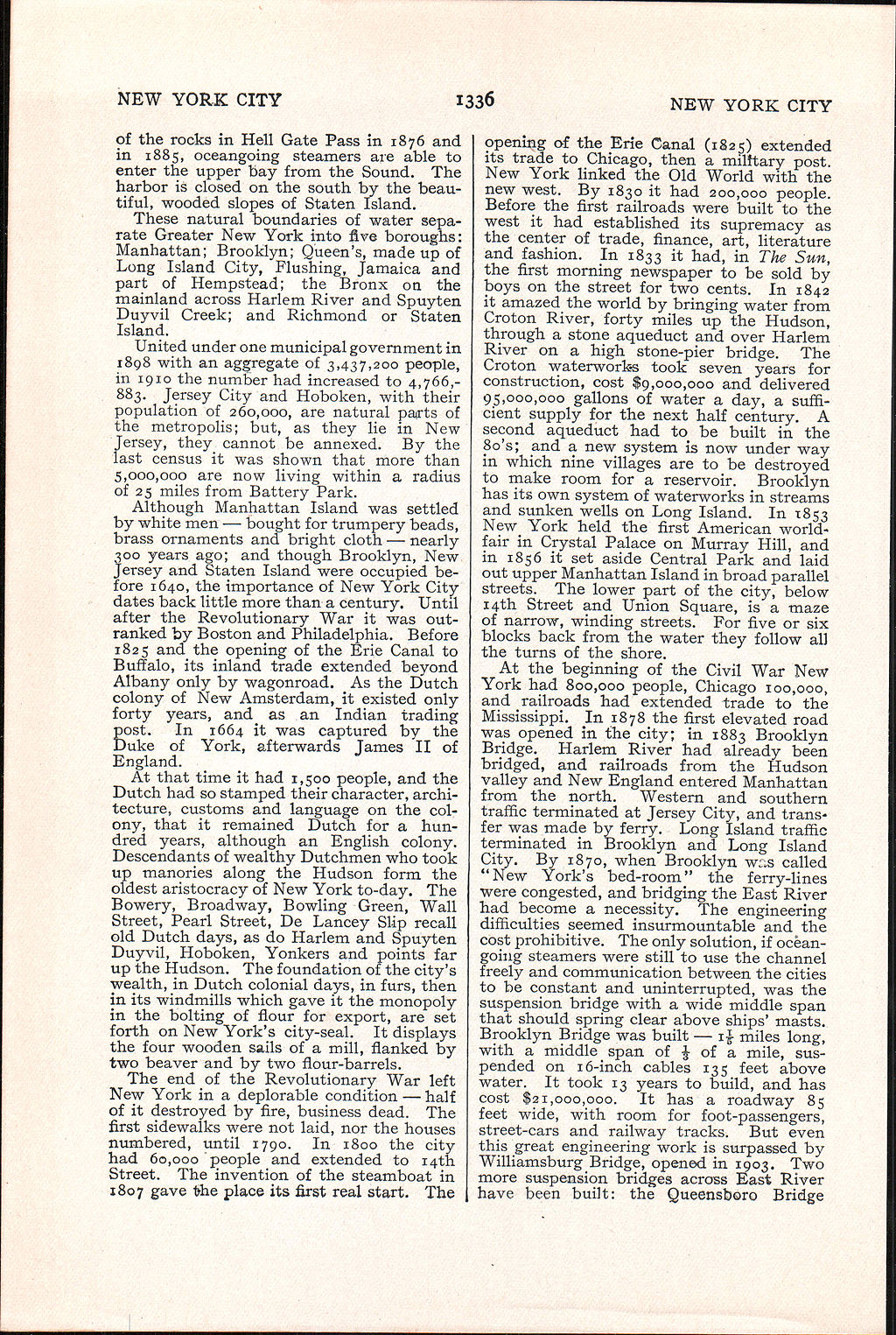of the rocks in Hell Gate Pass in 1876 and in 1885, oceangoing steamers are able to enter the upper bay from the Sound. The harbor is closed on the south by the beautiful, wooded slopes of Staten Island.
These natural boundaries of water separate Greater New York into five boroughs: Manhattan; Brooklyn; Queen's, made up of Long Island City, Flushing, Jamaica and part of Hempstead; the Bronx on the mainland across Harlem River and Spuyten Duyvil Creek; and Richmond or Staten Island.
United under one municipal government in 1898 with an aggregate of 3,437,200 people, in 1910 the number had increased to 4,766,883. Jersey City and Hoboken, with their population of 260,000, are natural parts of the metropolis; but, as they lie in New Jersey, they cannot be annexed. By the last census it was shown that more than 5,000,000 are now living within a radius of 25 miles from Battery Park.
Although Manhattan Island was settled by white men — bought for trumpery beads, brass ornaments and bright cloth — nearly 300 years ago; and though Brooklyn, New Jersey and Staten Island were occupied before 1640, the importance of New York City dates back little more than a century. Until after the Revolutionary War it was outranked by Boston and Philadelphia. Before 1825 and the opening of the Erie Canal to Buffalo, its inland trade extended beyond Albany only by wagonroad. As the Dutch colony of New Amsterdam, it existed only forty years, and as an Indian trading post. In 1664 it was captured by the Duke of York, afterwards James II of England.
At that time it had 1,500 people, and the Dutch had so stamped their character, architecture, customs and language on the colony, that it remained Dutch for a hundred years, although an English colony. Descendants of wealthy Dutchmen who took up manories along the Hudson form the oldest aristocracy of New York to-day. The Bowery, Broadway, Bowling Green, Wall Street, Pearl Street, De Lancey Slip recall old Dutch days, as do Harlem and Spuyten Duyvil, Hoboken, Yonkers and points far up the Hudson. The foundation of the city's wealth, in Dutch colonial days, in furs, then in its windmills which gave it the monopoly in the bolting of flour for export, are set forth on New York's city-seal. It displays the four wooden sails of a mill, flanked by two beaver and by two flour-barrels.
The end of the Revolutionary War left New York in a deplorable condition — half of it destroyed by fire, business dead. The first sidewalks were not laid, nor the houses numbered, until 1790. In 1800 the city had 60,000 people and extended to 14th Street. The invention of the steamboat in 1807 gave the place its first real start. The opening of the Erie Canal (1825) extended its trade to Chicago, then a military post. New York linked the Old World with the new west. By 1830 it had 200,000 people. Before the first railroads were built to the west it had established its supremacy as the center of trade, finance, art, literature and fashion. In 1833 it had, in The Sun, the first morning newspaper to be sold by boys on the street for two cents. In 1842 it amazed the world by bringing water from Croton River, forty miles up the Hudson, through a stone aqueduct and over Harlem River on a high stone-pier bridge. The Croton waterworks took seven years for construction, cost $9,000,000 and delivered 95,000,000 gallons of water a day, a sufficient supply for the next half century. A second aqueduct had to be built in the 80's; and a new system is now under way in which nine villages are to be destroyed to make room for a reservoir. Brooklyn has its own system of waterworks in streams and sunken wells on Long Island. In 1853 New York held the first American worldfair in Crystal Palace on Murray Hill, and in 1856 it set aside Central Park and laid out upper Manhattan Island in broad parallel streets. The lower part of the city, below 14th Street and Union Square, is a maze of narrow, winding streets. For five or six blocks back from the water they follow all the turns of the shore.
At the beginning of the Civil War New York had 800,000 people, Chicago 100,000, and railroads had extended trade to the Mississippi. In 1878 the first elevated road was opened in the city; in 1883 Brooklyn Bridge. Harlem River had already been bridged, and railroads from the Hudson valley and New England entered Manhattan from the north. Western and southern traffic terminated at Jersey City, and transfer was made by ferry. Long Island traffic terminated in Brooklyn and Long Island City. By 1870, when Brooklyn was called “New York's bed-room” the ferry-lines were congested, and bridging the East River had become a necessity. The engineering difficulties seemed insurmountable and the cost prohibitive. The only solution, if oceangoing steamers were still to use the channel freely and communication between the cities to be constant and uninterrupted, was the suspension bridge with a wide middle span that should spring clear above ships' masts. Brooklyn Bridge was built — 11⁄5 miles long, with a middle span of 1⁄3 of a mile, suspended on 16-inch cables 135 feet above water. It took 13 years to build, and has cost $21,000,000. It has a roadway 85 feet wide, with room for foot-passengers, street-cars and railway tracks. But even this great engineering work is surpassed by Williamsburg Bridge, opened in 1903. Two more suspension bridges across East River have been built: the Queensboro Bridge
